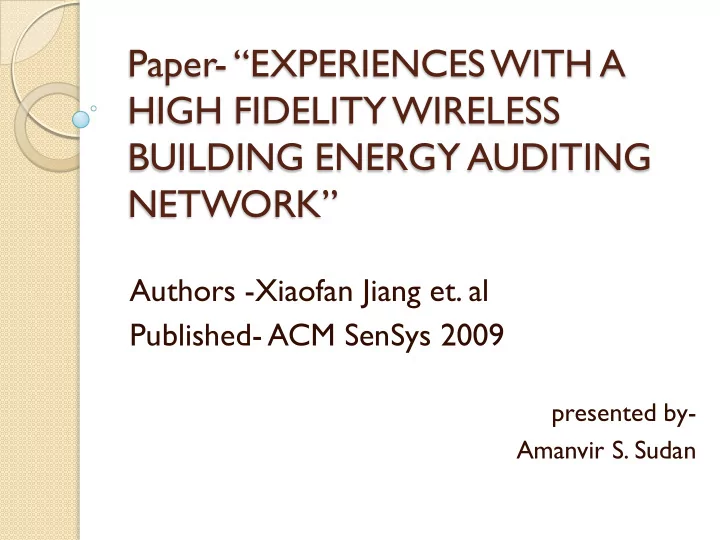

Paper- “EXPERIENCES WITH A HIGH FIDELITY WIRELESS BUILDING ENERGY AUDITING NETWORK” Authors -Xiaofan Jiang et. al Published- ACM SenSys 2009 presented by- Amanvir S. Sudan
What this paper is about? A wireless sensor network Used to monitor electrical usage in a building Design, Deployment and Experiences
Motivation behind Paper? 72% of total Electrical Energy utilized in residential and commercial buildings 30% goes waste How can we reduce the wastage?
How can we reduce the wastage? Need to identify ◦ Where it is going waste ◦ When it is going waste Need to understand ◦ How buildings use Energy ◦ Over both space and time domain ◦ By function, and per-individual
How can we reduce the wastage? Need to understand – LOAD TREE It helps in determining energy flows Helps in devising strategies to measure the energy consumptions in a better way
How can we reduce the wastage? Load Tree
How can we reduce the wastage? Energy meters do provide coverage Provide full coverage but not a detailed coverage We need detailed coverage to realize our goal
Coverage Can we get detailed coverage? Possible but requires money!! So coverage is limited by the number of energy measuring devices. Seek ways to improve existing coverage
Improving Coverage How can we improve coverage? Need to accurately guess consumption of unmetered devices By creating models of the behavior of each unmetered device by using measured data of similar devices. ◦ Scale the measured data by using the available aggregate measurement from the parent device
The Data and Sampling Model of Appliance behavior is as good as the Data collected There are often multiple ways to measure the usage of a single appliance e.g. Refrigerator ◦ Directly by Power Meter ◦ Log of door openings ◦ Internal light measurements ◦ Record of proximity events What behavior should be captured?
The Data and Sampling How often it should be captured?
Appliance Signature Analysis Modern electronic devices are a composition of many sub-components Natural level of disaggregation at sub component level
Appliance Signature Analysis
Additivity Sum of power of children node equals the power of parent node Can freely combine a subset of children under the same parent Optimal Disaggregation
Decomposition By function By space By Individual Associate Meta-data with each device in a database, such as type of appliance, where it is, and to whom it belongs.
Decomposition by Function Just need to sum data from devices of similar type
Decomposition by Space Each load in the database- assign x,y and z co-ordinates Maintain a database of logical and physical spaces like offices, hallways etc- defined by a bounding box consisting of six planes Spatial decomposition- filter load by their co-ordinates Still Issues- e.g. Lighting- Illuminate single desk or an entire room- Smoothing techniques
Decomposition by Individual Simply sum all the energy consumption for devices belonging to the same owner Shared Load? Energy Consumption per capita Energy Usage No of Users .
Implementation Computer Science Lab taken as case study Analyze the structure of load tree Deploy plug load meters and light sensors to measure energy consumption Explore several techniques for maximizing coverage
Energy Monitoring Network
Energy Monitoring Network 38 Wireless AC plug load meters ◦ 9 AC meters at power strip level ◦ Remaining at appliance level ◦ Measured Real and Reactive power at a max sampling rate of 2.8KHz and load power up to 1800 W 6 Light sensors
Energy Monitoring Network Sensors and Meters part of the wireless ad hoc network Transmitted Energy and light readings once per minute to a server via UDP Each UDP packet includes: ◦ A sequence number ◦ Energy used in previous minute ◦ Average, Minimum, Maximum and last Instantaneous power in the interval
Energy Monitoring Network The server process timestamps the readings and stores them in a database for later processing
Research Project Identify devices based on their unique appliance signature
Recommend
More recommend